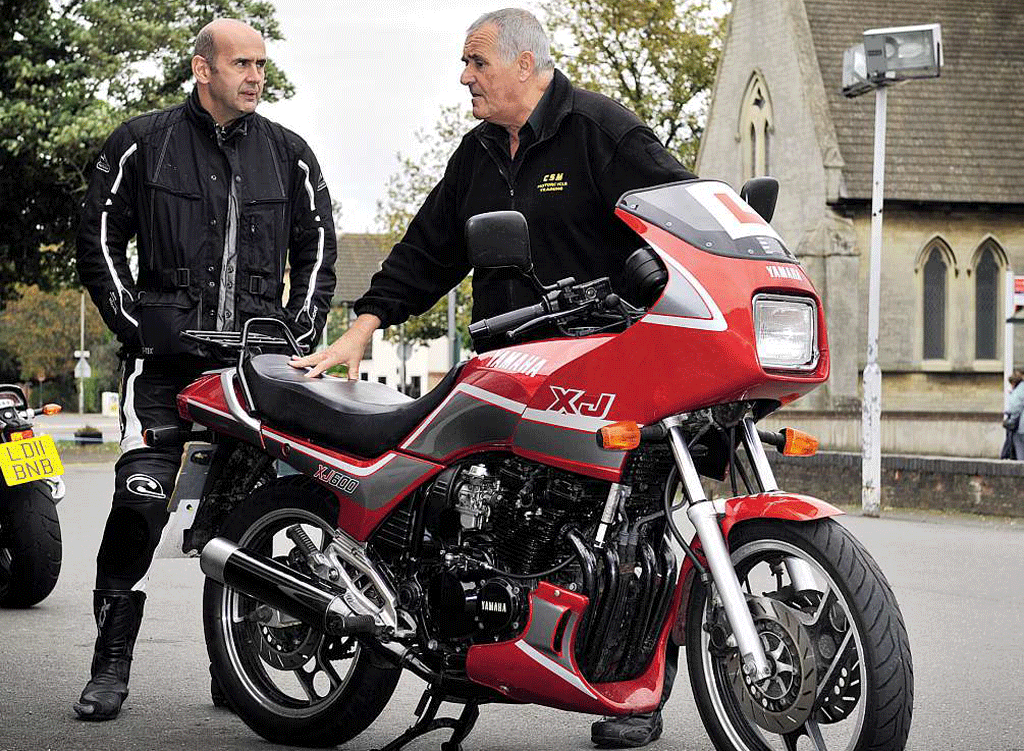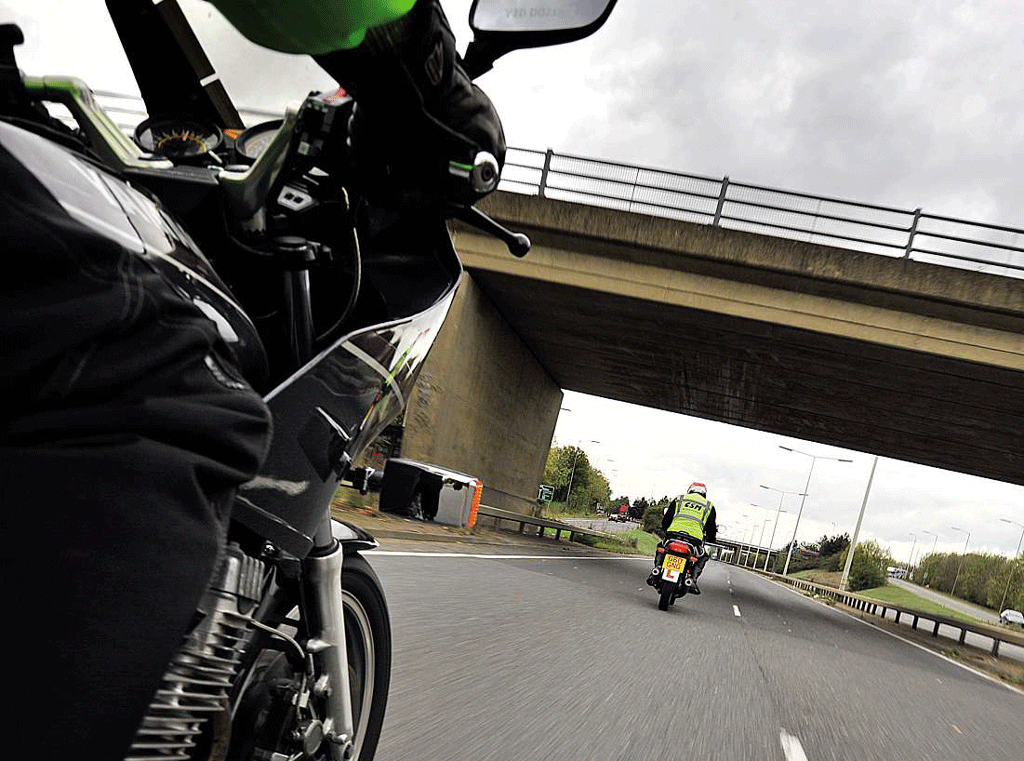
Jim Liskin of CSM training school in Peterborough has been a motorcycle instructor for 31 years. There’s not much he doesn’t know about passing the bike test. Here is 31 years of his wisdom condensed.
The test
It’s a 40 minute road ride with the examiner following behind. Before the ride, the examiner will check your bike to make sure it is roadworthy. He may also ask a couple of basic machine or maintenance questions.
During the ride the examiner will simply be looking to see that you can ride smoothly and, safely. That you can spot hazards and deal with them appropriately, that you understand about road positioning and appropriate use of speed and that you are observing the events around you as they unfold and responding accordingly.
You must also show proper control of your machine, consideration for other road users and indicate your intentions on the road clearly and safely. Do all of that and you’ll pass. This is not a case of riding to pass the test, it is all about smart and safe riding. At the end of the test the examiner may ask you some further questions.
You are allowed to make up to 5 minor errors during the test as long as they are not the same error repeated more than three times. Any serious error is an immediate fail.
Jim said: “Don’t forget the basics. Arrive at the test centre in plenty of time, with all the correct documents and you will have chance to settle your nerves, go to the loo and take a few minutes to remind yourself of the basics.
“Don’t get stressed. Make sure you have plenty of practice and get a few lessons in before you take the test. Try not to think about riding to pass the test – just do a good, normal, safe ride. And don’t get hung up on learning the local test routes. It’s a waste of time.”
Observation
Jim continues: “Remembering to do a lifesaver when pulling away from rest or when changing lane. Miss one of these and you’re halfway to failing already. Some people are so nervous they forget the very first one outside the test centre.
“Check your mirrors regularly and make your checks deliberate. Move your head a little so he can see you doing it. You’ll be surprised how much he can see from behind you because a good examiner knows exactly what to look for.
“Always take note of what’s going on around you. Again, make sure you move your head so the examiner can see you looking down side streets as you approach them or watching the traffic on a roundabout as you approach it.”

Communication with other road users
“Make sure other road users are aware of your presence and intentions. Don’t be afraid to use your horn when overtaking parked cars about to pull out of a parking spot.
“Also, use it when approaching a junction if there’s pedestrian about to cross. Too many people are scared of using the horn because they worry that it comes across aggressively. Don’t worry about that- it’s better that they know you are there than you have an accident.
“Use your pass light to let drivers ahead of you in the queue aware that you are coming through. Drivers inch out towards the white line desperately looking for a chance to overtake. They haven’t seen you behind, waiting and able to overtake more quickly and safely than they can. Flash your Iight- they’ve seen you now.
“Use your indicators correctly. If there’s nothing behind you to signal to, then you don’t have to. Likewise, if you are overtaking something on a dual carriageway, you do need to signal that you are pulling out, but don’t need to indicate that you are pulling back in. And don’t forget to turn them off. Again, it’s so easy when you are nervous -it’s also one of the most common faiIs.
“Don’t forget the obvious stuff too like body language. Move your head deliberately to look in your mirrors to show the driver behind that you have seen them. Make your changes in road position deliberate and clear.This indicates your intentions to other road users.”
Positioning
“Stay in the middle of your lane while riding normally. Owning your space makes any quicker vehicles plan their overtakes properly and gives you room to get out of the way.
“Always give parked cars plenty of room to allow for them pulling out or opening the door, but be aware of the effect this has on traffic coming the other way. If cars are double parked on a busy road, slow down and use as much space as you can.
“Don’t tailgate other vehicles. Sitting too close behind a car or truck reduces your forward visibility, lessens the chances that you will see their brake lights or indicators and gives you no time to stop if they brake hard or change direction quickly. Remember the two second rule and stick to it.
“Don’t cut corners when turning right from a main road into a minor one. This is one of the most common test fails. And don’t hug the kerb when truing left from a major road either. Correct positioning gives you the visibility so you can compete the manoeuvre safely.
“If a car turning right into a minor road, you can overtake to the left of it, but slow down to give yourself time to assess the traffic and be aware that other traffic might be turning right out of that junction.”
Speed
“The key word is ‘appropriate’. Too fast for the conditions or speed limit and you’ll fail. Too cautious and you’ll also fail.
“You should be keeping up with the flow of traffic and be prepared to overtake vehicles travelling too slowly. Speed limits must be observed at all times, although it may be permissible (at the examiner’s discretion) to speed up a little to complete an already-started overtake if to not do so makes it more dangerous.”

The common fails
Pulling away
“You will be asked to pull over and pull away again several times during the test. Remember that you are in control so only pull away when you are happy that is safe to do so. Many nervous candidates hear the examiner ask them to pull away and set off without looking properly – which is dangerous and a fail. Likewise, pulling over.
“When the examiner asks you to do this, look ahead for a safe place to do it. Stopping on double yellow lines is a fail, stopping on single yellows can be okay, depending on the other circumstances.”
Speed
“Breaking a speed limit is an immediate fail unless you are overtaking a vehicle which speeds up as you are alongside. But plenty of riders fail for riding too slowly, especially on a dual carriageway.
“You should always know what the speed limit is and ideally be riding a few mph below it, but the key phrase is ‘appropriate speed’. If the traffic is moving very slowly, then you must too. But if all the other traffic is breaking the speed limit, you have to stick to the limit.”
Filtering
“Filtering past stationary traffic is okay and failure to do so may result is a fail if the examiner is sure that there’s a big enough gap. What they don’t like is when you filter right to the front of the queue, which creates what the law calls ‘a third lane’.
“The correct thing to do is filter until you are a couple of cars from the front of the queue and then, slow down, indicate left, make eye contact with the driver you are about to pull in in front of and pull in.”
Roundabouts
“The approach is crucial. If there is a vehicle in front of you, watch that, not the traffic on the roundabout. Because there might be a gap that you’re happy to go for but if the driver in front doesn’t go, he’ll be wearing your motorcycle as a boot mascot.
“Always keep the bike in gear with the clutch in. I knew one rider who failed because a gap appeared, but they’d put the bike in neutral so as they let the clutch out, the revs rose (which the examiner heard) but the bike didn’t move. The examiner went and hit the pupil up the rear. Legally it was the examiner’s fault, but the pupil failed because they weren’t in the appropriate gear for the situation.
“Stay in the middle of your lane as go round the roundabout. Control it. Always stay in the left hand lane on a three lane roundabout if you are going straight on. This prevents someone in the left lane who is actually turning right cutting across you.”


